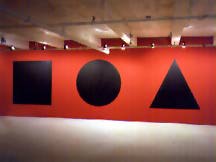- MAIN INDEX | ARTIST INDEX
| March 14 - April 4, 1981 Sol Lewitt
| |
 Sol Lewitt, installation view of "Wall Drawing", 1981. Photo Peter MacCallum. 18K |  Sol Lewitt, installation view of "Wall Drawing", 1981. Photo Peter MacCallum. 18K |
| Sol Lewitt-takes his line from geometry
John Bentley Mays In his famous book on architecture, the Roman engineer Vitruvius tells an interesting old story about the Socratic philosopher Aristippus. It so happened that the sage was shipwrecked off Rhodes, and washed ashore along with some of his travelling companions. But the place they had come to wasn't utterly desolate - Aristippus figured that out when he saw some geometrical markings on the shore. "Let us be of good cheer, for I see traces of man," cried the philosopher. "With that," Vitruvius adds, he made for the city of Rhodes, and went straight to the gymnasium.' The point is clear. Where there's geometry, there must be people nearby - since geometry is just about the most unmistakably human thing we're capable of doing. Given the basic humanity of geometry, it may come as a surprise to find that many contemporary painters, both figurative and abstract, think plain geometrical figures are chilly, "intellectual," inhuman things best kept out of art or buried deep beneath lots of colorful, painterly gestures, thrustings and parryings. Some gallery-goers, as well, seem to share this grumpiness about the classically elegant, geometrizing works of such artists as Carl Andre, Robert Smithson and Sol Lewitt - as though art based on plain-dealing, uncomplicated ideas and images, for some reason, shouldn't be called art at all. If there is a cure for such impatience, it's the splendid array of new sculptures, prints, drawings, and photo-works by New York artist Sol Lewitt, now on view at the David Bellman Gallery (134 Peter St.) and at Mercer Union (29 Mercer St.). lt's hard for me to imagine that anyone, however skeptical about the kind of humane art Lewitt does, could come out of either show unmoved by the freshness and beauty of these works. The most immediately engaging thing on view is the paste-up, at David Bellman's, of Lewitt's newest book of photographs, entitled Autobiography. In this handsomely installed piece, two aspects of the artist himself come through with equal clarity: his restless visual curiosity and his unstoppable interest in visual order - and, more to the point, the order conferred by the grid. The piece (or book) is very much like an archeological "book of the dig," or systematic presentation of what was dug up. But the site Lewitt decided to excevate, was his own flat on New York Lower East Side. First, he photographed everything in the place, from books and floorboards to toothbrushes, plants or cooking pots. Then he began to match the formal visual properties of all the things and lay them out side-by-side in grid-pattern groups of nine. The result: complex inquiry in living space that both as intimate as a diary (what could be more revealing than your choice in decoration or the titles in your library, and as coolly systematic as the Dewey Decimal System. Lewitt's interest in the subtle interplay between human emotion and spatial system - between enclosure and disclosure - has been central to his work ever since he became well-known as an artist in the early Sixties. It's all there in his superb piece at Mercer Union - a physical space he's analyzed precisely, then dramatically invaded and transformed with great, black geometrical emblems emblazoned directly on its four walls, painted stark: red, blue, yellow and white. And, at the David Bellman Gallery, we see the same kinds of analytic muscle exercised in the workmanlike drawing and the elegant ordering of two dimensional space in Six Geometric Figures and All Their Combinations (1980) - a wall-sized series of silk screened depictions of big, variously juxtaposed circles, 'trapezoids, triangles, oblongs, squares and parallelograms.' Lewitt's best explorations of space and structure, however, are the constructions at David Bellman - modular buildups of three dimensional grids made of aluminum or wood, painted flat white, whose progress expresses simple, immediately recognizable numerical series. (Example: one cube is set beside a little unit made of 2 x 2=4 cubes, which in turn abuts another unit composed of 3 x 3 = 9 cubes, etc. until the artist decides to stop.) The scale of these pieces is perfect: if they were any smaller, they would look like models for something far bigger; if they were larger - as is, the tallest one comes up to my nose - they would start looming, or turning into buildings. They are, however, neither models-nor buildings - but serenely austere matrices slowly opening and closing as you move around them, drawing the mind and eye into their depths and angles, into the complex plays of lights and shadows, spaces and volumes, and other surprising attractions which, the artist admits; even he couldn't have foreseen when he was figuring out the basic numerical sequences they're based on. To appreciate these works for what they are - and they are merely what they are - no big-deal symbolism is involved - you'll need time. These large pieces can't be rushed. But given the kind of time and quiet contemplation all good art deserves, they gradually drop the look of rather severe, text-book demonstrations - if they look that way at all. which some people seem to think they do. Gradually they reveal themselves to be, if not exactly the signs of salvation Aristippus saw on the Rhodian shore, then at least the sensuous, graceful works of human geometry they certainly are.
| |